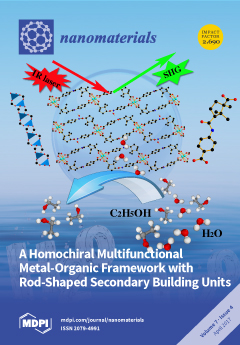Open AccessArticle
Breakthrough to Non-Vacuum Deposition of Single-Crystal, Ultra-Thin, Homogeneous Nanoparticle Layers: A Better Alternative to Chemical Bath Deposition and Atomic Layer Deposition
by
Yu-Kuang Liao, Yung-Tsung Liu, Dan-Hua Hsieh, Tien-Lin Shen, Ming-Yang Hsieh, An-Jye Tzou, Shih-Chen Chen, Yu-Lin Tsai, Wei-Sheng Lin, Sheng-Wen Chan, Yen-Ping Shen, Shun-Jen Cheng, Chyong-Hua Chen, Kaung-Hsiung Wu, Hao-Ming Chen, Shou-Yi Kuo, Martin D. B. Charlton, Tung-Po Hsieh and Hao-Chung Kuo
Cited by 6 | Viewed by 5878
Abstract
Most thin-film techniques require a multiple vacuum process, and cannot produce high-coverage continuous thin films with the thickness of a few nanometers on rough surfaces. We present a new ”paradigm shift” non-vacuum process to deposit high-quality, ultra-thin, single-crystal layers of coalesced sulfide nanoparticles
[...] Read more.
Most thin-film techniques require a multiple vacuum process, and cannot produce high-coverage continuous thin films with the thickness of a few nanometers on rough surfaces. We present a new ”paradigm shift” non-vacuum process to deposit high-quality, ultra-thin, single-crystal layers of coalesced sulfide nanoparticles (NPs) with controllable thickness down to a few nanometers, based on thermal decomposition. This provides high-coverage, homogeneous thickness, and large-area deposition over a rough surface, with little material loss or liquid chemical waste, and deposition rates of 10 nm/min. This technique can potentially replace conventional thin-film deposition methods, such as atomic layer deposition (ALD) and chemical bath deposition (CBD) as used by the Cu(In,Ga)Se
2 (CIGS) thin-film solar cell industry for decades. We demonstrate 32% improvement of CIGS thin-film solar cell efficiency in comparison to reference devices prepared by conventional CBD deposition method by depositing the ZnS NPs buffer layer using the new process. The new ZnS NPs layer allows reduction of an intrinsic ZnO layer, which can lead to severe shunt leakage in case of a CBD buffer layer. This leads to a 65% relative efficiency increase.
Full article
►▼
Show Figures






